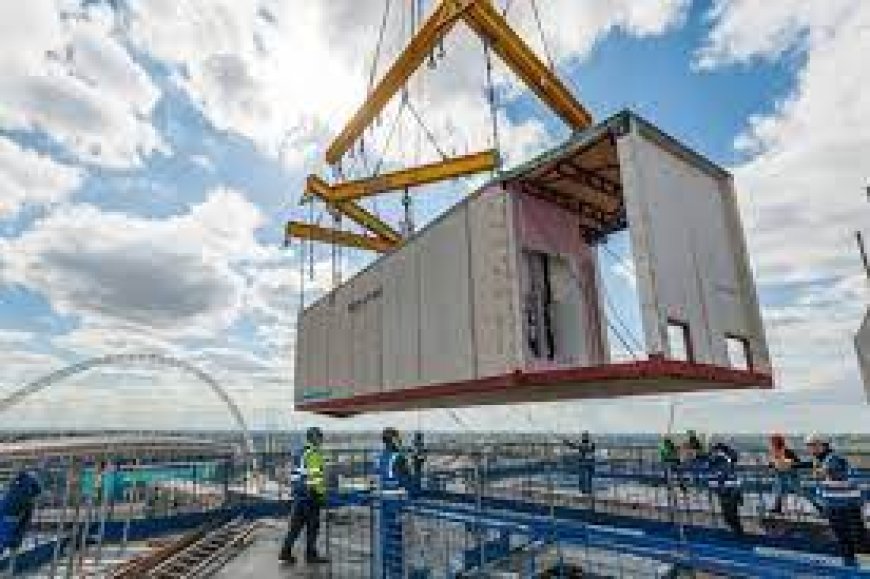The Global Modular Construction Market: Size, Growth, and Future Prospects by 2034
The Global Modular Construction Market: Size, Growth, and Future Prospects by 2034

The construction industry is evolving, with technological advancements and innovative methods changing the way buildings are designed, built, and delivered. Among these advancements, modular construction has emerged as a leading trend, revolutionizing the way structures are constructed. This method offers significant advantages in terms of cost, time, and sustainability compared to traditional construction techniques. In this article, we will explore the global modular construction market, its growth trajectory, key drivers, challenges, and the future outlook.
What is Modular Construction?
Modular construction is a process in which buildings or structures are prefabricated in sections (modules) in a factory setting before being transported and assembled on-site. These modules are often constructed with the same materials and quality standards as traditional construction, but the prefabrication allows for faster and more efficient construction timelines. This method is commonly used in residential, commercial, educational, healthcare, and industrial buildings.
The key benefit of modular construction is its ability to reduce both construction time and costs, making it an attractive option for developers and contractors. It also reduces material waste and the environmental impact of construction projects by manufacturing the modules in a controlled factory environment.
Market Overview: Modular Construction Industry Value and Growth
The global modular construction market was valued at approximately USD 63.19 billion in 2024. This market is expected to grow at a CAGR of 12.4% during the forecast period of 2025-2034, reaching a market value of USD 180.94 billion by 2034. This substantial growth can be attributed to a combination of factors such as the increasing demand for cost-efficient and time-saving construction solutions, urbanization, and the need for sustainability in the built environment.
Key Drivers of Market Growth
Several factors are driving the expansion of the modular construction market. These include:
1. Cost-Efficiency and Time Savings
One of the most compelling advantages of modular construction is its ability to reduce both time and costs associated with traditional construction methods. By manufacturing modules off-site in a controlled environment, projects are less subject to delays caused by weather, labor shortages, or other site-related issues. The assembly of modules is fast, often reducing construction timelines by as much as 30% to 50%. This is especially beneficial for industries where time-sensitive projects are critical, such as in healthcare and education sectors.
Moreover, the factory-controlled setting allows for better resource management, reducing the chances of material waste. The use of prefabricated parts reduces the need for on-site labor, which can also cut labor costs significantly. Developers and contractors can leverage modular construction to achieve quicker project turnarounds and lower overall costs.
2. Growing Demand for Affordable Housing
The demand for affordable housing is one of the primary drivers of the modular construction market. With rising populations, particularly in urban areas, there is an increasing need for cost-effective housing solutions. Modular construction provides a way to build homes more quickly and efficiently, making it an ideal solution for meeting the growing need for affordable housing. Furthermore, the speed of construction can help alleviate housing shortages by providing homes in a fraction of the time it takes using traditional building methods.
In countries like the United States, the United Kingdom, and several European nations, modular construction is being increasingly adopted as a way to address the housing crisis. The method enables the construction of high-quality, energy-efficient homes in a shorter time, helping to meet housing demands while keeping costs within budget.
3. Sustainability and Environmental Benefits
Sustainability is a key concern in the construction industry, as the sector is one of the largest contributors to global greenhouse gas emissions. Modular construction, with its emphasis on prefabrication, offers significant environmental benefits. It minimizes material waste by producing building components in a factory-controlled environment, where raw materials can be more efficiently used.
In addition, modular buildings are often designed with energy efficiency in mind, featuring advanced insulation and other sustainable building materials that reduce energy consumption over time. This has made modular construction particularly attractive to companies and governments looking to reduce their environmental footprint.
Modular construction also supports the concept of a circular economy, as structures can be disassembled and reused, minimizing the long-term impact on the environment. This sustainability angle makes it appealing to developers who are aiming for green building certifications such as LEED or BREEAM.
4. Urbanization and Increasing Infrastructure Demand
The continued trend of urbanization is also a significant factor driving the modular construction market. With more people moving to cities, there is an increased demand for infrastructure and buildings. Modular construction allows developers to meet this demand quickly while minimizing disruption to existing infrastructure.
The method is also well-suited for large-scale infrastructure projects such as schools, hospitals, hotels, and office buildings. With fast construction times, modular methods help cities keep up with their growing populations without compromising on quality or environmental considerations.
5. Technological Advancements
Advances in technology have significantly improved the modular construction process, making it more cost-effective and adaptable to a wider range of projects. The integration of Building Information Modeling (BIM) and other digital tools has enhanced the design and planning phases of modular construction, leading to more accurate project specifications and reduced errors. Additionally, automation and robotics in manufacturing processes are improving the precision and speed of module production.
The advent of 3D printing and advanced robotics has further enhanced the capabilities of modular construction, enabling the creation of complex, customized modules that were previously difficult to produce. As these technologies continue to develop, modular construction will likely become even more efficient and versatile.
Challenges Facing the Modular Construction Market
While the modular construction market presents many opportunities, it is not without challenges:
1. Transportation and Logistics
The transportation of large modular units from the factory to the construction site can present logistical challenges, particularly when dealing with tight urban areas or remote locations. The modules must be transported via trucks or other vehicles, often requiring specialized equipment. This can increase costs and complicate project planning, particularly in densely populated areas where roads may not be able to accommodate large loads.
2. Limited Consumer Awareness
Although modular construction offers significant benefits, consumer awareness of this building method remains relatively low compared to traditional construction techniques. Many potential clients may still be unfamiliar with the advantages of modular buildings, and there may be misconceptions about the quality or longevity of modular structures.
As the industry continues to grow, educating developers, contractors, and end-users about the benefits of modular construction will be essential for driving broader adoption.
Key Applications of Modular Construction
Modular construction is highly versatile, with applications spanning a wide range of industries. Some of the key sectors that benefit from modular construction include:
1. Residential Buildings
Modular construction is widely used in the residential sector to build single-family homes, apartment complexes, and affordable housing units. The speed of construction and cost-efficiency of modular building methods make them ideal for addressing housing shortages in urban areas.
2. Commercial Buildings
Modular construction is also gaining traction in the commercial building sector, where office buildings, retail stores, and hotels can be constructed in less time and at a lower cost. The flexibility of modular design allows developers to create customized commercial spaces that meet specific business needs.
3. Healthcare and Education
Hospitals, clinics, schools, and universities are increasingly utilizing modular construction to meet the demand for new spaces. Modular buildings can be used for temporary or permanent structures, with fast delivery times making them ideal for addressing urgent needs in the healthcare and education sectors.
The Future Outlook of the Modular Construction Market
The future of the modular construction market is exceptionally promising. With the increasing demand for fast, cost-effective, and sustainable construction solutions, modular construction is expected to continue to gain market share in both residential and commercial projects.
Technological advancements in automation, robotics, and digital design will further enhance the speed, accuracy, and customization capabilities of modular construction. As cities continue to expand and the need for sustainable building solutions becomes more urgent, modular construction will play a key role in shaping the future of the global construction industry.
What's Your Reaction?















![Noots Focus Reviews [Truth Exposed 2025]!](https://news.bangboxonline.com/uploads/images/202501/image_430x256_678e3b94881a1.jpg)










